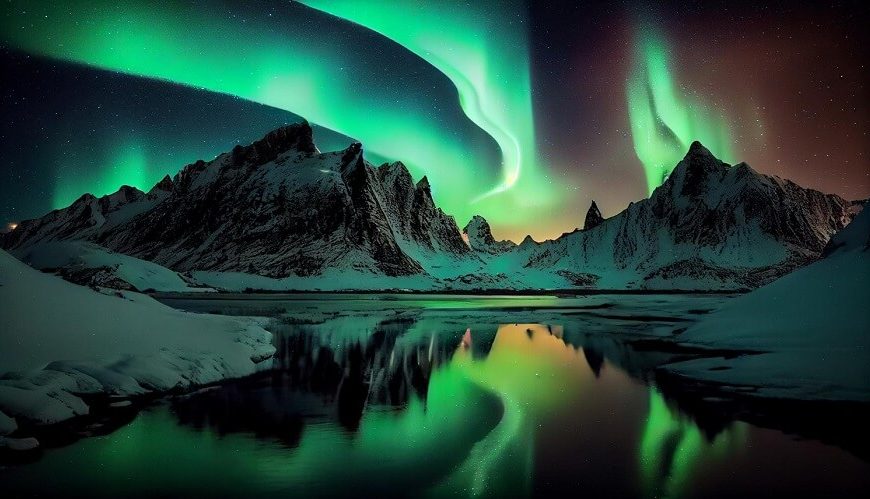The world has always been fascinated by India, a country known for its iconic landmarks, delectable food, and Bollywood films, but there are many other lesser-known aspects that make the country even more fascinating to visit. In this blog, we will explore the top 10 interesting facts about India, some of which are relatively unknown, so whether you’re an adult looking to broaden your horizons or a parent looking for facts about India for kids, this article will definitely be of interest to you.
Among the most amazing visual occurrences in nature are auroras. Auroras were originally thought to be a mystery, but it is now known that they are caused by charged particles from space interacting with the earth’s atmosphere.
The Mythology Of The Northern Lights:
Naturally, we now understand the cause of the northern lights. However, it seems sense that our predecessors had trouble understanding what they were seeing before we learned the science.
Indigenous people attempted to make sense of what they saw, and as a result, the northern lights are connected with many myths and stories worldwide.
- The northern lights feature in Norse mythology:
- The northern lights play a part in Chinese dragon legends:
- Some Europeans saw the aurora as a harbinger of war:
- Japanese culture associates the aurora with luck:
According to a Norse myth, the lights are reflections from the Valkyrie’s shield and armour. Which of the slain would be allowed passage into Valhalla would be decided by these female warriors. According to Norse traditions, these ribbons of light, which pulsed green, also functioned as an archway leading to Valhalla.
It is usually uncommon to see the lights in China due to the latitude. This indicates that the impact was tremendous on the rare occasions when a major solar event resulted in a sighting in China.
These infrequent light displays are thought to represent a conflict between good and evil dragons, which is claimed to be connected to several ancient Chinese dragon stories.
Not everyone connected the lights to positivity or the gods. It is indeed reported that, in the British Isles, the skies “blazed red” only a few weeks prior to the French Revolution.
Meanwhile, France and Italy regarded the lights as a terrible portent, a sign of impending disaster or war. Watch your health if you happen to view the lights!
There is also fecundity in the aurora stories! For instance, a kid born during a Northern Lights show is said to be endowed with intelligence, excellent appearance, and good luck in Japanese culture.
The science of the northern lights:
The science behind the lights fascinates us just as much as the tales and traditions around them. Let’s now examine our current understanding of the reasons for this impressive light display.
- An aurora display is actually a distortion in the earth’s magnetic field:
- The northern lights occur around 100km above the earth:
- The northern lights are only visible when it’s dark, but they can occur at any time:
- The lights occur in an oval-shaped band around the poles:
- The best places to see a display change over time:
- Auroras constantly change shape:
- A Norwegian scientist was the first to explain the aurora phenomenon:
- The term’ Aurora Borealis was coined in 1619:
- Captain James Cook named the ‘aurora australis’:
- The oldest known record of an aurora dates back to 2600 BC:
- There are hundreds of documented reports of ‘auroral sound’:
- The most common aurora colours are red and green:
- For night owls only!
The earth’s magnetic field is distorted when solar wind enters the planet. Some of the charged particles enter the atmosphere near the two magnetic poles, but the majority are repelled away.
Light is produced when charged particles collide with gases in our atmosphere, releasing photon energy.
It might feel as though you could practically reach out and touch the northern lights when you’re witnessing an exceptionally powerful show. However, the lights are actually quite high in the atmosphere of our planet.
How lofty? The lights can be discovered much higher, but they are often located between 90 and 130 kilometres above ground level, according to Norway’s UiT.
The Northern Lights can show up at any point of the day, as opposed to what some individuals believe. Our eyes, nevertheless, demand darkness in order to perceive them.
It follows that looking for lights is not ideal during the days surrounding a full moon. It also clarifies why, in order to increase your chances of spotting one, you should avoid areas with bright lighting.
Recall the charged particles that move into our atmosphere in the vicinity of the poles? Prediction software shows what looks like an oval around the poles, which is how a northern lights display is often seen from space.
The planet rotates under the auroral oval, which is stationary in reference to the sun. However, the farther the charged particles enter the atmosphere from the poles, the stronger they are, expanding the oval and the visible range along the way.
The magnetic poles, not the geographic poles, are what the auroral oval is related to. The auroral ovals are taken with the magnetic poles as they travel throughout time. Although changes are small from year to year, they might become considerable over time.
Experts think that the auroral oval was most likely over southern Norway 500 years ago. This implies that although it’s a fantastic day to observe the lights in northern Norway right now, things won’t stay this way forever.
The shifting flow of charged particles and the fluctuating magnetic fields are what create the patterns and forms of auroras.
The “beams” can move incredibly quickly as they dance across the sky. The almost vertical light beams seen in auroras are the visual fingerprints of electrical currents moving up and down the magnetic field lines, which are nearly vertical at high latitudes.
Because the plasma particles in auroras are moving in reaction to the earth’s magnetic field, they resemble moving curtains of light.
People have been in awe of the breathtaking spectacles that periodically light up the night sky for thousands of years. Hundreds of tales and ideas have been proposed to explain what is now known as auroras, which were formerly believed to be signs of impending disaster. However, a relationship with the sun was not discovered until around a century ago.
The sun-earth link was established by Norwegian physicist Kristian Birkeland (1867–1917), who was the first to explain the origin of the aurora.
The Roman goddess of dawn, Aurora, and the Greek word for the north wind, Boreas, are the sources of the phrase “aurora borealis,” which refers to the Northern Lights. The question of who named them first, Italian scientist Galileo Galilei (1564–1642) or Frenchman Pierre Gassendi (1592–1655), is up for controversy.
A similar phenomenon in the southern hemisphere was given the term “aurora australis” by Captain James Cook after his expedition in Resolution (1772–75) to the Antarctic. The name “Australis” comes from the Latin for “southern.”
Some impressionistic cave drawings are thought to show auroras in the sky, according to archaeologists. In China in 2600 B.C., the first recorded auroral citation was written: “Fu-Pao, the mother of the Yellow Empire Shuan-Yuan, saw strong lightning moving around the star Su, which belongs to the constellation of Bei-Dou, and the light illuminated the whole area.” According to Indigenous Australian oral traditions, auroras are also noteworthy. Similar to Native American societies, Aboriginal people also equate auroras with fire, death, blood, and omens.
Less widely known than auroral displays’ amazing light displays are tales of mysterious noises that are heard during them. Frequently, these stories describe a hissing sound that is followed by a harsher crackling or clapping sound.
Whether and how strongly electrons smash with nitrogen or oxygen determines the hues of the polar lights. Purple, pink, and white light is produced when nitrogen and oxygen mix. Nitrogen often emits blue light, while oxygen releases greenish-yellow or red light. We are more likely to observe the oxygen green line emissions at night since green light is the colour most sensitive to in our eyes. Sometimes, auroras of nitrogen are blue or a blue-red (purple) blend. We are unable to view certain nitrogen aurora emissions because they are in the ultraviolet portion of the spectrum.
Even these displays can happen at any time of year, they are most likely to happen in late March and late September, near the equinoxes. Due to the longer evenings, the winter months are inherently excellent for viewing auroras. Generally speaking, the greatest viewing periods are between 10 pm and 2 am, and the brightest displays linger for around one to three hours. There isn’t a magic hour, though, so those who are serious about seeing auroras typically monitor our real-time geomagnetic indices, which indicate the intensity of geomagnetic activity, and stay up late if necessary!
Wonder and inspiration never fade from the Northern Lights, a magnificent clash of solar particles and Earth’s magnetic field. Distinguishing reality from imagination enables us to recognise the actual wonder of this cosmic dance. The Northern Lights offer an enthralling experience that defies scientific explanation, whether you’re expecting to see them from more southern latitudes or are planning a trip to the Arctic Circle. Remember the complex interaction of charged particles, magnetic fields, and Earth’s atmosphere that turns the night sky into a work of celestial beauty as you stare at the shimmering colours overhead.
For more such interesting blogs, Visit EuroKids
















